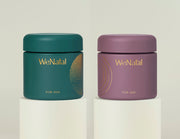
We both know the exact sound of a silent ultrasound room.
Ronit lost a heartbeat at 12 weeks, just after turning 41, and watched the birthday balloons in the kitchen deflate a little faster that year. Yet eleven months later, baby Emma arrived just four days after her 42nd birthday—our “rainbow” reminder that storms can end in color.
Vida walked the same hallway of grief, not once but twice. She endured D&Cs, kept working through the tears, and wondered if her toddler would ever meet a sibling. The loneliness lifted only when we opened up and realized our miscarriages had happened one week apart. Together, we promised to rewrite the story, not just for us, but for every family who would come after.
Vida and Ronit with their families expecting their rainbow babies
RELATED: From heartbreak to hope: Why we created WeNatal
Busting the “advanced maternal age” myth
Doctors love the phrase advanced maternal age (AMA). But we’re here to say age is only one data point. Biological age (how healthy your cells are) often matters more than the number on your driver’s license. Ronit’s telomere test at 41 showed a biological age of 32, a finding that fueled her comeback plan.
Key ways to keep biological age younger than chronological age
-
Correct micronutrient gaps by adding in more B vitamins, antioxidants, and omega‑3s
-
Protect mitochondria with sleep, stress reduction, and targeted supplements (Coenzyme Q10 (CoQ10), N-acetyl cysteine (NAC), Alpha-lipoic acid (ALA))
-
Lower toxic load from plastics, fragrances, and heavy metals
-
Move your body daily—blood flow is oxygen, and oxygen is egg quality. Consistent movement improves pelvic circulation, delivering vital nutrients and reducing inflammation in the ovaries and uterus, which supports healthier egg maturation and a more receptive uterine lining.
The missing 50 percent: Male fertility & miscarriage risk
Half of miscarriages trace back to sperm DNA damage, yet most couples are told, “Mom’s age is the problem.” Our research (and personal epiphany) proved otherwise: Antioxidants like L‑carnitine, vitamins C & E, zinc, and NAC can boost live‑birth odds up to five‑fold when taken by him.
Action plan for partners
-
Three months of preconception prep—that’s one full sperm cycle
-
Daily male prenatal with methylated folate, zinc, selenium, CoQ10, NAC
-
Lifestyle tweaks: avoid hot tubs, limit alcohol, lift weights, sleep 7–8 hours
RELATED: Gut health and fertility: Why gut health matters for fertility and beyond
Yes, you can influence egg quality after 40
Chromosomal errors usually happen in the final months of egg maturation, meaning targeted support right now still matters. Nutrients that support mitochondrial function (CoQ10, NAC, alpha lipoic acid, melatonin, DHA, vitamin D) plus gentle circulation boosters (acupuncture, walking, yoga) all moved the needle for us.
Here's a list of exactly what steps we took to conceive our rainbow babies, from the testing we underwent to the nervous-system care we embraced.
RELATED: What to know about omega-3 and pregnancy
Your next steps if you’re TTC after 35 or after loss
-
Test, don’t guess—work with a functional medicine practitioner to check your nutrient status, hormone panels, and your partner's semen parameters.
-
Pick a prenatal pair—one for her and him with methylated folate, antioxidants, and minerals, at clinically relevant doses to not only prevent deficiencies but to support optimal nutrient stores before conception.
-
Think “WE”—make big lifestyle changes together; isolation feeds anxiety.
-
Give yourselves a 90‑day runway—eggs and sperm both develop on roughly three‑month cycles.
-
Seek out support—Look for therapists, support groups, fertility coaches, or simply a trusted friend who can hold space for what you're going through.
Vida and Ronit with their daughters 2025
A note from WeNatal on having babies later in life
Our rainbow babies taught us that fertility isn’t just a women’s health issue or a numbers game. It’s a whole‑body, two‑person wellness journey. Age, loss, and dashed expectations all matter, but so do micronutrient stores, mitochondrial health, and the love you pour into each other. Whether you’re 28 or 42, addressing hidden nutrient deficiencies and building optimal reserves is one of the most impactful gifts you can give future little humans and yourselves.
We created WeNatal for Her & WeNatal for Him to make that step simple, evidence‑based, and one that you can take together. Wherever you are on the path to parenthood, we’re cheering you on, one healthy cell at a time.
RELATED: Your fertility meal plan: A week of healthy, easy recipes
References
Sharma R, Biedenharn KR, Fedor JM, Agarwal A. Lifestyle factors and reproductive health: taking control of your fertility. Reprod Biol Endocrinol. 2013;11:66. Published 2013 Jul 16. doi:10.1186/1477-7827-11-66



